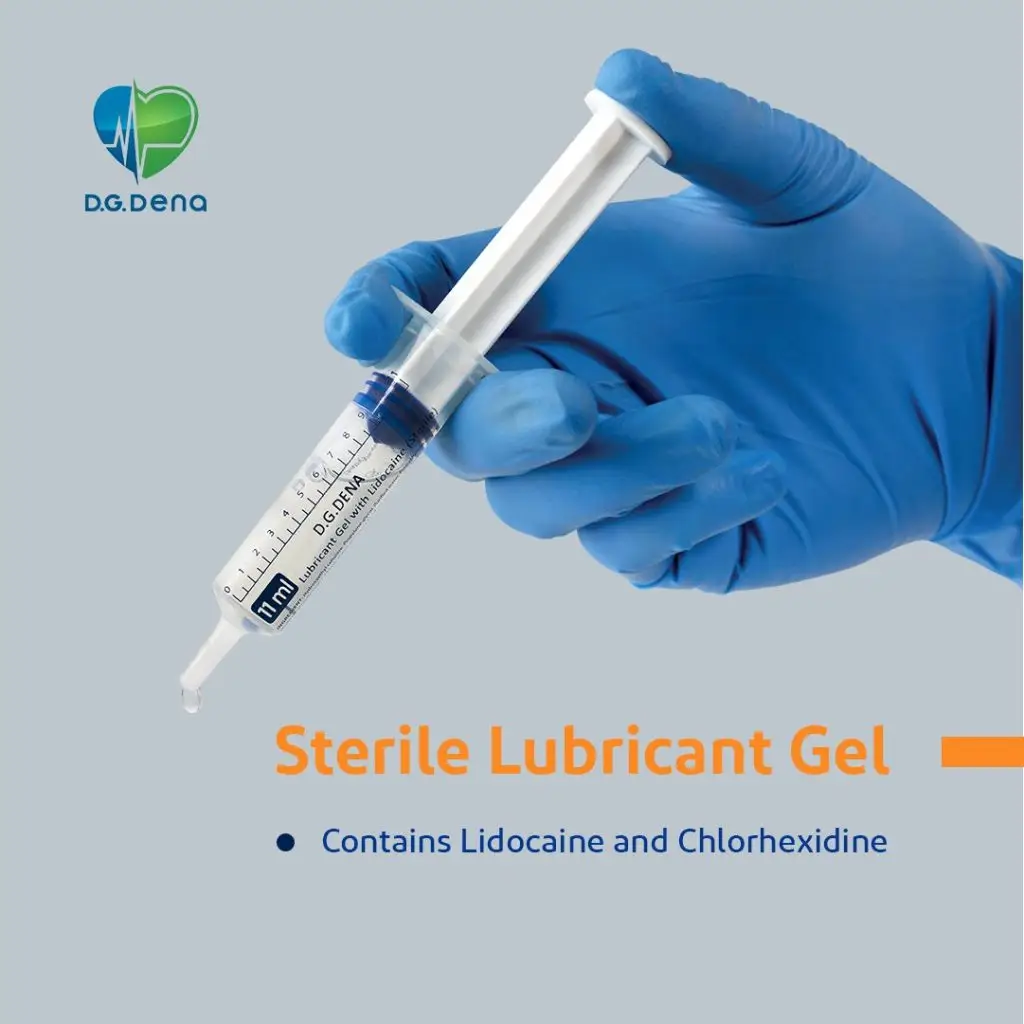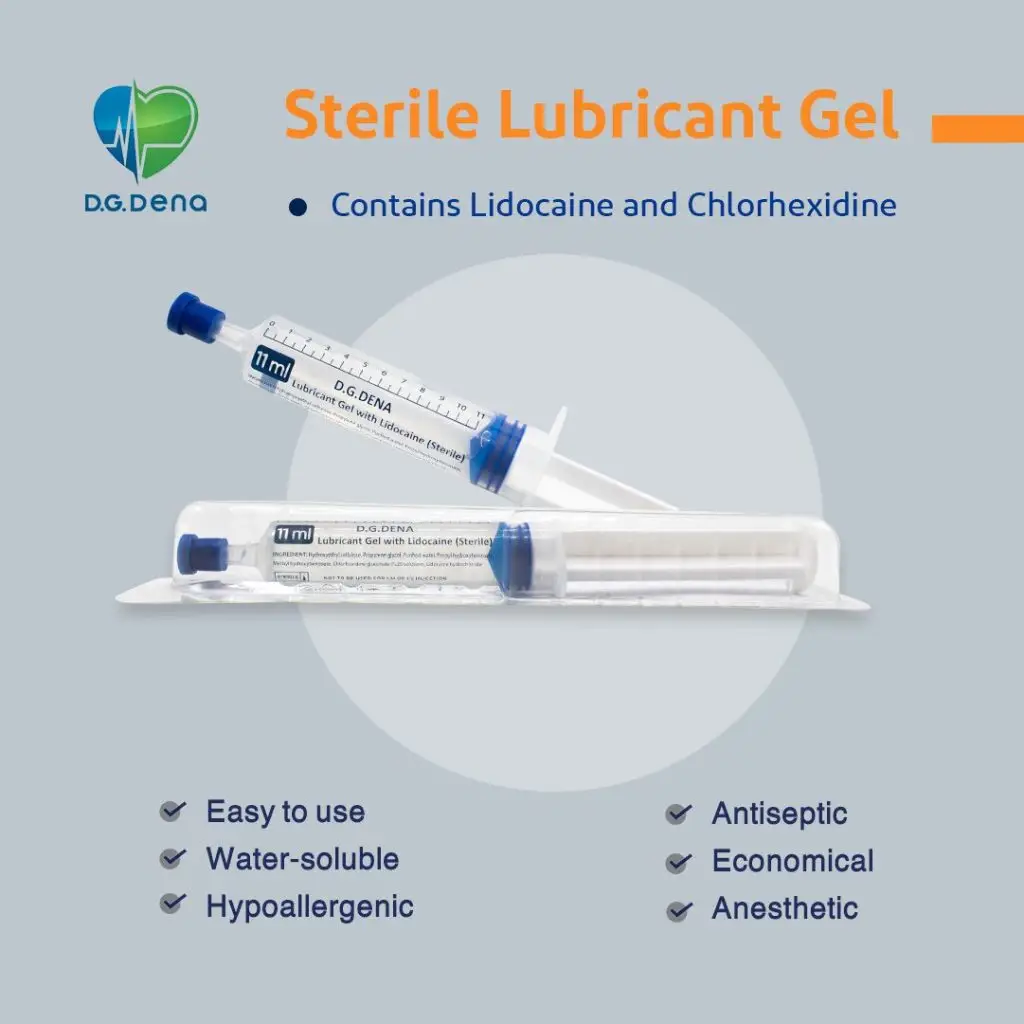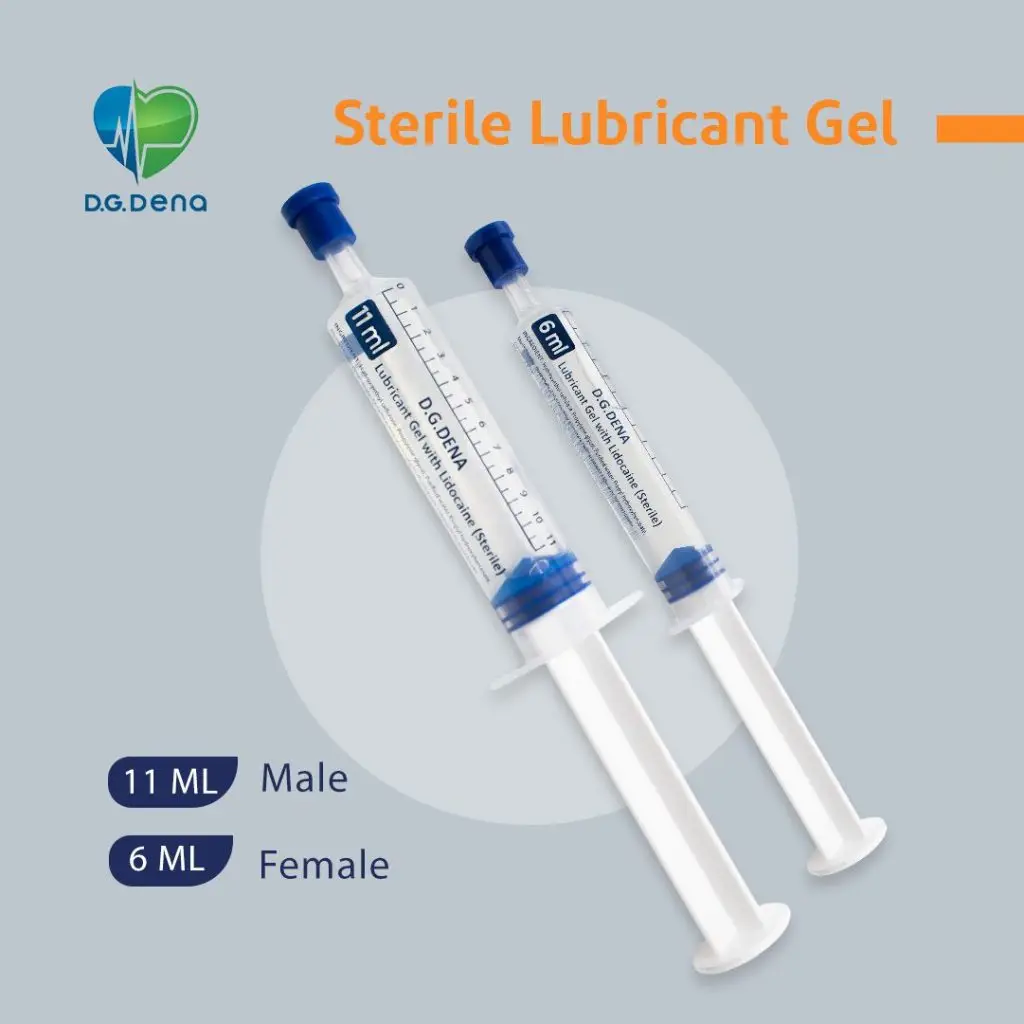DG DERM lubricant gel
It is a water-based gel that is highly compatible with the human body and medical devices, i.e., catheters. Since it is water-soluble, it is easy to clean and reduces the long-term medical device-body contact risk. According to the ISO 10993 standard, biocompatibility has been determined by tests and proven to be safe and well-tolerated.
DG DERM GEL ensures that it will not irritate due to its optimum pH range of 5.5-6.5. The second essential factor is the gel osmolality, which is perfectly balanced to prevent any potential damage to tissue cells. Urethral compatibility of this lubricant gel safeguards against irritation or damage upon application.
DG DERM Lubricant Gel Applications
DG DERM Lubricant Gel is versatile and can be used in a variety of medical procedures that require simple medical instruments insertion into the body. The lubrication, comfort, and friction reduction qualities of DG DERM Lubricant Gel make it ideal for use across various applications, some of which include the following:
- Colposcopy
- Cystoscopy
- Endoscopy
- Colonoscopy
- Hysteroscopy
DG DERM Lubricant Gel Key Features
DG DERM Sterile Lubricant Gel is highly body compatible with an optimum pH range between 5.5 and 6.5, such that it neither irritates nor damages body tissue. Its water solubility also ensures that it is easily removable from the body.
Lubricant gel additional features:
Lubricity
Lubricity of urinary catheterization lubricants is the measurable property that determines the lubricant effectiveness at reducing friction during catheter insertion and removal. This helps in decreasing patient discomfort and damage to internal tissues. Two parameters coefficient of friction and viscosity are very crucial to assure DG DERM Lubricant Gel maximum comfort and effectiveness.
Coefficient of friction
Coefficient of friction (COF) is a dimensionless value defining the ratio of friction force to normal force between two surfaces. For catheterization lubricants, a low COF is required for easy insertion and withdrawal of the catheter through the lumen. The decreased friction enables easier movement, reduced tissue irritation, and improved procedural ease and patient comfort.
Viscosity
Viscosity is a quantification of resistance to fluid flow and is responsible for the ease with which the lubricant coats the lumen or catheter surface and the duration it stays there. The viscosity in this product is balanced so that the whole lumen or catheter surface can be coated with ease and the film stays on for the required duration. If viscosity is too great, the gel may be harder to apply, resulting in inadequate lumen coverage and potentially causing blockage issues.
Antiseptic
Urinary Tract Infections (UTIs) are very prevalent infections in both community and healthcare settings, making effective prevention and treatment a priority.
Statistics indicate that in the United States, there are approximately 7 million outpatient and over 1 million inpatient visits annually due to UTIs. UTIs account for about 20-30% of healthcare-associated infections (HAIs) and are one of the most prevalent hospital infections. About 75-80% of hospital-acquired UTIs are related to catheterization. Infection rates tend to be higher in intensive care units (ICUs) due to increased catheter duration and the critical patient nature. About 15-25% of hospitalized patients are catheterized during their hospitalization. The catheter-associated urinary tract infections risk (CAUTIs) increases with the length of catheter use by 5-7% per day. There is a 50% chance of bacteriuria in patients with catheters in place for more than 7 days (Bacteria in urine), but not all are symptomatic infections. Antiseptic lubricant gels are highly effective at reducing CAUTI incidence. Hospitals participating in the National Health Safety Network (NHSN) program reported 30-50% reductions in CAUTI rates. DG DERM Lubricant Gel, by the potent antiseptic activity of chlorhexidine gluconate, significantly minimizes CAUTI risk. A precisely balanced concentration in this ingredient minimizes the allergic reactions as well.
Local Anesthesia
DG DERM Lubricant Gel contains 2% lidocaine, a safe and effective concentration for urethral instillation. It provides topical anesthesia without much risk of systemic side effects. Lidocaine has an anesthetizing effect on the lining of the urethra, bringing relief from the pain and discomfort of catheterization, particularly in those patients who have hypersensitive urethras or those who undergo frequent catheterization. The anesthetic effect, coupled with reduced resistance to catheter insertion, makes the procedure easier and less likely to result in trauma, particularly for patients who have urethral strictures or abnormalities.
In individuals with anxiety or discomfort due to previous catheterizations, lidocaine reduces discomfort, enabling patient relaxation and cooperation during the procedure. In addition, lidocaine’s numbing effect can also hasten recovery by lessening urethral trauma and discomfort, minimizing inflammation and irritation risk, and shortening healing time.
Catheterization can be painful, especially for patients who require repeated procedures, such as those suffering from chronic urinary retention. The anesthetic effect of lidocaine enhances patient tolerance, making the procedure less traumatic for both patients and healthcare professionals. Lidocaine also inhibits involuntary muscle contractions, such as urethral sphincter spasm, which also enhances comfort and reduces pain upon catheter insertion.
On topical application in usual concentrations (e.g., 2%) in lubricating gels, lidocaine significantly reduces the danger of systemic side effects. It is a very useful local anesthetic that does not cause drowsiness or other systemic effects. The lidocaine action is rapid, usually 3 to 5 minutes, and therefore it makes the patient feel the effect early and decreases catheterization delays. Maximum anesthesia is usually attained within 10 minutes, and its effect can last for 30 to 60 minutes; ideal for catheterization procedures majority.
Precautions and Side Effects
Although allergic reactions to lidocaine or any local anesthetics are rare, it is important to check the allergy history of the patient prior to use.
Anesthetic gel overuse in special circumstances may result in systemic absorption, and symptoms such as dizziness, drowsiness, or even more serious complications may arise. Some patients may also experience mild irritation or local discomfort, but they are largely temporary and soon resolve.
Pre-filled Syringe
DG DERM Lubricant Gel comes in pre-filled syringes, 6 ml for women and 11 ml for men. The concept of this packaging has some significant advantages, rendering the catheterization more comfortable, secure, and efficient.
Adaptation to Anatomical Differences in the Pre-filled Syringe
6 ml pre-filled syringe for women: Due to the shorter length of the female urethra (approximately 4 cm), a smaller amount of lubricant is sufficient for catheterization. The 6 ml syringe is the ideal volume of gel, an effective but not wasteful amount.
11 ml pre-filled syringe for men: Because of the longer male urethra (approximately 20 cm), more lubricant volume is necessary in order to reduce friction and ease catheter insertion. The 11 ml syringe offers an adequate volume of gel to lubricate the entire male urethra for comfortable and smooth catheterization.
Sterility and Safety in Pre-filled Syringes
Pre-filled syringes are provided in sterile packaging to prevent CAUTI, which significantly reduces the contamination risk compared to non-sterile packaging or manual handling. Single-use sterile packaging ensures cross-contamination between patients is prevented.
Pre-filled Syringes Convenient to use
The pre-filled syringe’s ready-to-use design streamlines and speeds up the catheterization process. With no measuring or manual application of lubricant required, the process is quicker for doctors and nurses and minimizes the cross-contamination threat. The syringe design also delivers accurate and consistent lubricant delivery, which helps to promote better distribution and minimize pain and discomfort during the process.
Related Articles
The effectiveness of a lidocaine-based lubricant was evaluated in a 2021 article published in the Bosphorus Medical Journal. The results demonstrated that the product played a significant role in reducing patient pain during prostate cancer evaluation via intrarectal biopsy.
Pain Tolerance: Intrarectal Lidocaine Gel vs. Ultrasonic Gel vs. Nerve Block
Another study published in the Journal of Obstetrics and Gynecology, USA, found that applying 2% lidocaine gel to the catheter and cotton during postvoid residual (PVR) urine volume assessment and Q-tip testing significantly reduced patient discomfort compared to water-based gel. Based on these findings, the study recommends using 2% lidocaine gel instead of water gel for direct catheterization of the female urethra and Q-tip testing.
Urethra Catheterization & the Q-Tip Test
Another study published in the University Hospitals of Leicester-NHS journal in the United States addresses various aspects of urinary catheterization, including catheter selection, procedures for male and female catheterization, catheter care, urine culture guidelines, methods for collecting urine samples from catheters, checking for catheter leakage, potential complications of urinary catheterization, catheter removal procedures, and self-catheterization guidelines for nursing staff. The study also emphasizes key measures to reduce CAUTI, including proper cleansing, ongoing care of pigtail nephrostomy catheters, and the correct procedure for suprapubic catheter replacement.
Urethra Catheterization UHL Policy
This document provides a comprehensive discussion on the importance of lubricant gel and lidocaine products in pain reduction. It serves as an excellent guide for assessing catheterization risks and demonstrates how lubricant gel application can effectively minimize these risks.
A study conducted in the UK and published in the British Journal of Community Nursing examined the challenges of pain in patients undergoing urinary catheterization. The study highlighted a lidocaine-containing gel product, noting its significant effectiveness in reducing pain associated with the procedure. The report emphasized that one of the key factors in minimizing pain and other risks, such as trauma, is the proper technique of catheterization, which must be thoroughly taught and practiced.
Optilube Active: Lubricants in Urinary Catheterization
A study conducted in South Korea and published in the Journal of The Korean Society of Emergency Medicine evaluated the effectiveness of lidocaine in sterile lubricant gel. The research involved 54 patients with an average age of approximately 50 years. Using the Visual Analog Scale (VAS) to assess pain, the study found that the product’s pain-reducing impact was significantly greater compared to the control group. Additionally, no cases of sensitivity were reported in the study.
Local Anesthesia for Urethra Catheterization
An assessment of lidocaine’s effectiveness in reducing pain during the catheterization process, published in the Canadian Journal of Health Technology in 2020, used lidocaine concentrations ranging from 2% to 5% and measured an effective time span between 5 to 25 minutes for the lubricant gel. Notably, this comprehensive study concluded that lidocaine was more effective in men than in women.
Urinary Catheter Anesthesia: Effectiveness & Cost Review
A 2019 study conducted at the University of Inonu Malatya, Turkey, compared the effectiveness of two different products containing lidocaine for cystoscopy. The results demonstrated that products with lidocaine were effective in reducing the pain associated with catheterization.
Lidocaine Gel (Dispogel vs. Cathejell) in Cystoscopy
A 2004 study conducted at Stony Brook Hospital’s Academic Emergency Medicine Department in New York found that lidocaine-containing gel was more effective in reducing pain during male catheterization compared to conventional gels. Patients also expressed a preference for topical gels containing lidocaine. The study concluded that lubricant gels with lidocaine are strongly recommended.
Comparison of Topical Anesthetics & Lubricants for Catheterization
A 2020 study published in the British Journal of Nursing in the UK investigated a lubricant gel effect containing lidocaine and chlorhexidine (CHG) on reducing CAUTI. The findings indicated that catheterization frequency reduction was beneficial in preventing CAUTI (HIN, 2017), though for some patients, a catheter-free approach remains unfeasible. The study highlighted a successful alternative approach at NNUH Hospital, where they significantly reduced hospital-associated urinary tract infections (HAI-UTI) from 17% of all hospital infections in 2011 to just 1% in 2018. This achievement was made possible by switching to a catheterization gel containing lidocaine and chlorhexidine.
Choosing a Lubrication Gel for Catheterization: One Trust’s Rationale
A 2020 study published in the Annals of Clinical and Analytical Medicine in Turkey examined lubricant gels application during catheterization. The results confirmed that lubricity primarily protects the urethra from damage, thereby reducing the risk of stricture formation. It was found that 6 ml of lubricant for women and 11 ml for men is sufficient for the successful urethral catheters’ insertion. Furthermore, lubricants containing lidocaine significantly reduce pain during the catheter passage phase, which is typically the most painful part of urethral catheterization.
Petroleum Jelly vs. Water-Based Gels in Urethra Catheterization
Final Conclusion in Articles Evaluation
According to the research cited in the mentioned studies, employing lubricant gel is a critical factor in the catheterization process. Overall, catheterization in urology is a critical component of patient care, yet it involves distinct challenges that require careful attention and expertise. Studies have shown that lubricant gels containing lidocaine and chlorhexidine (CHG) in prefilled syringes are highly effective in catheterization procedures. These gels offer several advantages, such as single-dose packaging with specific volumes for men and women, lubricity, anesthetic and antiseptic properties. One key concern has been sensitivities related to CHG. However, further evaluations from reputable sources indicate that CHG sensitivity risk during catheterization is low. According to the Royal College of Anaesthetists in the UK, the incidence of severe reactions to CHG is only 0.78 per 100,000 cases. Additionally, a randomized clinical trial by Kelly et al. in the UK found that using a lubricant gel with CHG reduced the risk of CAUTI by 50%. Furthermore, a comprehensive study conducted across 21 hospitals in Australia with 1,642 participants showed a 94% reduction in CAUTI risk, with no reports of allergic or harmful effects from CHG.
According to a statistical review of various studies, concerns about hypersensitivity and anaphylaxis are extremely low when using lubricant gels containing lidocaine hydrochloride at 2%, CHG at 0.05%, and parabens at less than 0.08% (with the combined total of CHG and parabens barely reaching 0.13%). As a result, this product is classified as low-risk by the UK’s Royal Society of Anaesthetists. It is important to emphasize that trauma remains the primary concern during catheterization. When trauma occurs, the potential for allergic responses to ingredients, infections, and product failure rises significantly.




